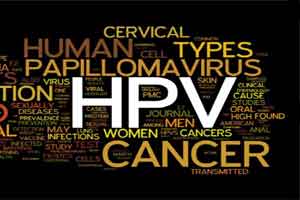- Home
- Editorial
- News
- Practice Guidelines
- Anesthesiology Guidelines
- Cancer Guidelines
- Cardiac Sciences Guidelines
- Critical Care Guidelines
- Dentistry Guidelines
- Dermatology Guidelines
- Diabetes and Endo Guidelines
- Diagnostics Guidelines
- ENT Guidelines
- Featured Practice Guidelines
- Gastroenterology Guidelines
- Geriatrics Guidelines
- Medicine Guidelines
- Nephrology Guidelines
- Neurosciences Guidelines
- Obs and Gynae Guidelines
- Ophthalmology Guidelines
- Orthopaedics Guidelines
- Paediatrics Guidelines
- Psychiatry Guidelines
- Pulmonology Guidelines
- Radiology Guidelines
- Surgery Guidelines
- Urology Guidelines
Men with HPV are 20 times more likely to be reinfected after one year

A new analysis of genital human papillomavirus (HPV) in men shows that infection with one HPV type strongly increases the risk of reinfection with the same type. In fact, men who are infected with the type responsible for most HPV-related cancers are 20 times more likely to be reinfected within one year. This increased risk suggests that infection confers no natural immunity against HPV, as is often the case with other viruses.
The study, published December in the Proceedings of the National Academy of Sciences, highlights the importance of vaccination for preventing the spread of HPV in young men before they become sexually active. Vaccination could potentially prevent reinfection in older men who have already contracted the virus.
"Vaccinating boys before HPV exposure could be a highly effective way to reduce the burden of HPV infection. Vaccinating men who have already been infected might also be effective," said Sylvia Ranjeva, a PhD student in the University of Chicago Department of Ecology and Evolution and the Pritzker School of Medicine, who led the study.
HPV is the most common sexually transmitted infection. Approximately 40 percent of women and 45 percent of men in the United States are infected, and it is a major cause of genital warts and cancers of the genitals, mouth and throat. There are more than 200 genetically-distinct HPV types; vaccines protect against four to nine of the most common, disease-causing types.
Ranjeva and her UChicago colleagues, including Greg Dwyer, PhD, professor of ecology and evolution and Sarah Cobey, PhD, assistant professor of ecology and evolution, wanted to understand what allowed so many different types of HPV to coexist. They analyzed data regarding the spread of the disease from the HPV in Men study, which tracked more than 4,000 unvaccinated men from three cities in Florida, Mexico and Brazil over five years from 2005 to 2009.
Usually, diversity of so many types of viruses happens as they compete to evolve different ways to evade the immune defenses of hosts. The new analysis showed no evidence of such competition among HPV types, however. Instead, the diversity of HPV types may stem from recurring infections of particular types within individuals. While relatively few people are infected with any one type, the high overall HPV prevalence occurs because nearly half the adult population carries at least one type of genital HPV. The high risk of reinfection may be due to either auto-inoculation, spreading the infection by repeated contact between different sites on the body, or reactivation of a latent virus.
The results also show that men who are infected once with HPV16, the type responsible for most HPV-related cancers, are at 20 times higher risk of reinfection after one year, and 14 times higher after two years. The researchers saw the same effect in both men who are sexually active and celibate, suggesting that they are not reacquiring the virus from another sexual partner.
"That's what makes this a biologically significant result," Ranjeva said. "The best thing we can do is prevent the initial infection by vaccinating boys before sexual contact. However, if the increased risk of reinfection is due to auto-inoculation, then another effective strategy may be to vaccinate previously infected men as well."

Disclaimer: This site is primarily intended for healthcare professionals. Any content/information on this website does not replace the advice of medical and/or health professionals and should not be construed as medical/diagnostic advice/endorsement or prescription. Use of this site is subject to our terms of use, privacy policy, advertisement policy. © 2020 Minerva Medical Treatment Pvt Ltd